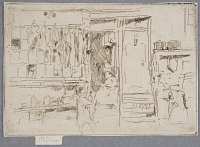Etchings Institutions search term: grolier club
The Little Rag Shop, Milman's Row | ||
| Number: | 265 | |
| Date: | 1886 | |
| Medium: | etching and drypoint | |
| Size: | 71 x 103 mm | |
| Signed: | butterfly at upper left | |
| Inscribed: | no | |
| Set/Publication: | no | |
| No. of States: | 2 | |
| Known impressions: | 6 | |
| Catalogues: | K.257; M.253; W.209 | |
| Impressions taken from this plate (6) | ||
KEYWORD
TITLE
'Old Clothes Shop' (1886, Frederick Wedmore (1844-1921)). 2
'The Rag Shop' or 'Shop Millmans Row' (1887/1888, Whistler). 3
'The Little Rag Shop - Chelsea' (1888, Wunderlich's) 4
'Rag Shop Chelsea small // Little Rag Shop ' (1890/1891, Whistler). 5
'Millmans Row - - The little rag shop' (1890/1892, Beatrice Whistler (1857-1896)). 6
'The little rag shop' (1898, Wunderlich's). 7
'The Little Rag Shop. Milman's Row' (1903/1935, possibly Rosalind Birnie Philip (1873-1958)). 8
'Old-Clothes Shop, No. 1' (1909, Howard Mansfield (1849-1938); 1910, Edward Guthrie Kennedy (1849-1932)). 9
The numbering system introduced by Mansfield relates to the existence of a similar subject, The Rag Shop, Milman's Row [290], but is not actually needed.
Whistler's original title is not known for sure because of the similarity between this etching and The Rag Shop, Milman's Row [290]. However, it was clarified in later lists to include the scale ('little') as well as the site (Milman's Row). A composite title, 'The Little Rag Shop, Milman's Row', based on the title as recorded by Beatrice Whistler and by her sister, Rosalind Birnie Philip (1873-1958), has therefore been accepted.
2: Wedmore 1886 A (cat. no. 209).
3: List, GUW #13233.
4: G. Dieterlen to Whistler, 3 May 1888, GUW #07158.
5: List, [1890/1891], GUW #13236.
6: List, GUW #12715.
7: New York 1898 (cat. no. 209).
8: Envelope containing copper plate, University of Glasgow.
9: Mansfield 1909 (cat. no. 253).
DESCRIPTION
SITE
10: Robins 2007 , pp. 131-136.
Booth's map of the area shows that the inhabitants's income varied from very poor to adequate, and in 1899, as Robins comments, 'The number of children aged between three and thirteen living in Justice Walk, 114, and Milman Street, 115, is astounding.' 11
11: Ibid.; Charles Booth, ed., Life and Labour of the People of London, 2 vols., London, 1889, 1891; Life and Labour of the People of London with Maps, 9 vols., London, 1892-1897.
DISCUSSION

